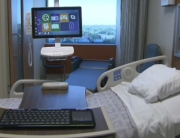Studies show that telehealth is a growing trend among hospitals and healthcare providers because of its wide reach and cost-saving capabilities. Telehealth is the sharing of health-related services by telecommunication technology, including telephone, live videoconferencing and email, typically between a patient and doctor or between health care professionals.
A patient in rural Ontario, for example, can have their x-rays shared with a radiologist in Toronto while a hospital can broadcast medical information to hundreds of medical professionals across the country via technology. Both of these examples demonstrate the broader range of services that can be delivered from a single telehealth platform that is extensible and capable of serving more than one functional need within a hospital. By investing in solutions that are multi-purpose, hospitals can further drive down costs while delivering better patient-centered care. A 2010 report by the World Health Organization (WHO) stated that telehealth “has already raised high hopes among policy makers with regard to its potential for delivering solutions for growing capacity problems.”
Patient Bedside Engagement Platform Supports Telehealth Strategy
Among those solutions, hospitals have found that telehealth services can reduce wait times, hospital admissions and hospital re-admissions. For example, studies in the US show a significant reduction in re-admission through ER when patients and their families viewed patient care education using collaboration technology prior to a patient being released from hospital. Patients can be watching education videos from their bedside pre-discharge, using the collaboration capabilities of a patient bedside engagement platform, while families can be watching the same educational videos from their homes. Using telehealth solutions to help patients participate more actively in their care is driving success. With these kind of capabilities, it’s no surprise the use of telehealth services grew at an average rate of 35 per cent per year (between 2007 and 2012), according to a Health Council of Canada study.
Care Teams Collaborate with Flexible, Device Agnostic Telehealth Platforms

As hospitals begin to modernize outdated entertainment systems – the old TVs that served a single purpose – there is a significant opportunity to invest in technology platforms that deliver multiple benefits and can support multiple devices. For example, using voice and video-conferencing to connect patients and doctors with clinicians or experts in other locations. This can be done right from the bedside where clinical records can be accessed and can connect care teams across multiple disciplines and geographies in minutes.
Hospitals Under the Gun to Cut Costs, Improve Services
An example of telehealth in action is at Partners HealthCare in Massachusetts where they used telehealth services to support cardiac patients. The hospital reported a 51 per cent reduction in heart failure hospital readmissions plus patients showed a better understanding of their health problem. The program resulted in an overall savings of more than $10.3 million.
Canada’s Health Care System Keen to Spend Less
Cutting costs is a huge incentive behind why more and more hospitals are developing telehealth systems. As Jeffrey Simpson wrote in a recent Globe and Mail piece on health care spending, hospitals are under the gun to look for ways to cut costs.
Simpson, who is author of the best-selling book Chronic Condition: Why Canada’s Health-Care System Needs to be Dragged into the 21st Century, wrote that from 2004 to 2010 health-care spending increased by about 7 per cent a year while this year in Ontario it is expected to increase by 2 per cent.
The educational component of telehealth combined with its ability to reach such wide audiences and save dollars are key reasons behind its success. But telehealth is about more than technology. In order for telehealth systems to work, they need a plan that includes process review, education and even lobbying to change fee structures from government. Next month we will explore common use cases that are driving healthcare success.







